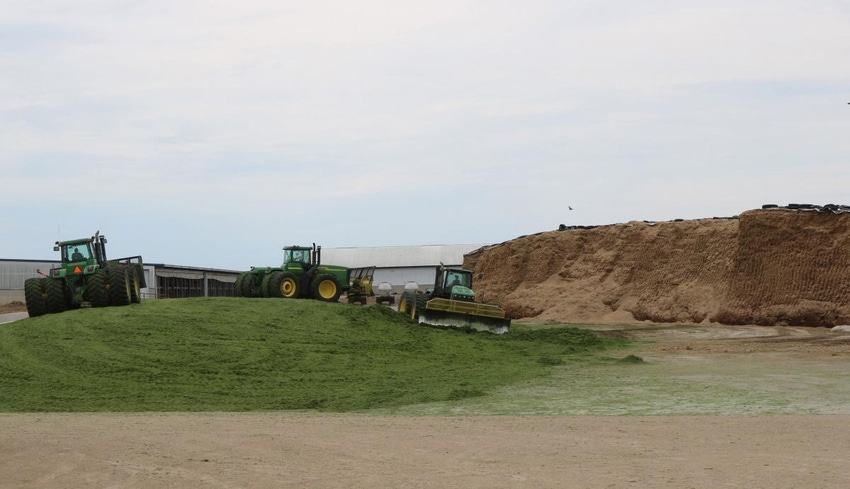Moisture critical for silage harvesting during wet year
Harvesting at greater than 40% dry matter reduces digestibility of fiber and starch and may cause packing issues.
October 15, 2019

With many flooded and saturated fields this fall, harvesting silage before corn dries past desired moisture levels or frost occurs may be a challenge for some producers, according to specialists at South Dakota State University (SDSU).
“With many acres of corn planted later than average this year, there are still options for farmers who want to produce wet feed. Equipment availability and plant moisture should help determine what works best for an operation. If precipitation continues, famers may have to wait until freeze-up to enter some fields,” SDSU extension agronomy field specialist Sara Bauder said.
Creating quality silage is most dependent on harvest plant moisture. Ideally, when chopping silage, the plant should be 32-38% dry matter, SDSU said.
“Moisture calculation is key and given the genetics of today’s corn varieties, the relationship between milk line and plant moisture content may not always be accurate,” SDSU extension dairy field specialist Tracey Erickson added.
Harvesting at greater than 40% dry matter reduces digestibility of fiber and starch and may cause packing issues. More specifically, the optimum silage moisture falls in the following ranges, depending on storage type: 55-60% for upright oxygen-limiting silos, 60-65% for upright stave silos, 60-70% for bags and 65-70% for bunkers, they said.
“In other words, wetter silage tends to work better in bags, bunkers and piles for better packing. Drier silage tends to work better in upright silos to minimize seepage,” Bauder said.
Chopping dry silage
Although not ideal for optimum feed value and storage, if a producer chooses to chop silage at more than 40% dry matter, Bauder and Erickson said there are several considerations to take into account, such as:
* Reduce chop length to release more plant fluids and improve packing.
* Use a kernel processor to improve digestibility. The more mature the corn is, the less digestible it becomes.
* Use silage inoculants to improve fermentation. Liquid inoculants may be more effective in dry silage.
* If piling or using bunker silos, use extra-heavy tractors for packing, and pack no more than 6 in. at a time.
* Blend wetter feeds with dry silage like forage sorghum, alfalfa, later-planted green corn or wet distillers grains.
* Place wettest forage on the top layer of the pile or horizontal bunker for sealing and weight. Adding water to the top layer of the pile may also help with this.
* Another option, although time consuming, is to mix the wetter and drier feeds in a total mixed ration wagon prior to ensiling.
* Cover tightly with silage plastic and/or oxygen barrier to keep the environment as anaerobic as possible.
“Some producers may choose to add water as they pile or fill silos; however, it takes approximately 7 gal. of water for every ton of silage to raise moisture content one point, and corn plant material absorbs water quite slowly. Therefore, a large amount of water would be required at a very fast rate to keep up with most silage harvest processes, making wetting nearly impossible to render major results," Erickson noted.
Chopping earlage
With an energy content higher than corn silage but lower than corn grain and with a similar protein content to corn silage, Bauder suggested earlage as a good alternative. The ideal moisture content for chopping earlage is 35-40%. A silage chopper with a snapper head can be used. Some producers have successfully used combines set to retain a portion of the cob with the grain. Much like silage, if harvested too wet, seepage may occur, and if harvested too dry, it will not pack well, which causes excessive spoilage.
Bauder said things to consider when chopping earlage include:
* Make sure every kernel is cracked and the cob portions are no larger than a thumbnail to improve pack density and digestibility.
* Consider using a kernel processor to improve digestibility.
* Use inoculants to improve fermentation.
* If piling or using bunker silos, use extra-heavy tractors for packing.
* Cover tightly with silage plastic and/or an oxygen barrier to keep the environment as anaerobic as possible.
If silage is too wet when harvested, there is a risk of butyric acid forming and nutrients being lost due to seepage, the specialists said. Silage that is greater than 70% moisture should not be harvested and should stand in the field for a few more days. On the other hand, if it is too dry, silage will not ferment or pack adequately, resulting in mold development.
“In addition, flooded corn can contain many contaminants. Watch for corn ear molds, stalk molds and if the plant is quite dirty, soil contaminants. Preservatives and fermentation do not lower the concentration of these toxins in feed. If there are concerns or any of these issues have been discovered in the field, first consider identifying ear or stalk diseases,” Erickson said.
Source: South Dakota State University, which is solely responsible for the information provided and is wholly owned by the source. Informa Business Media and all its subsidiaries are not responsible for any of the content contained in this information asset.
You May Also Like



